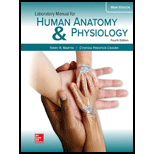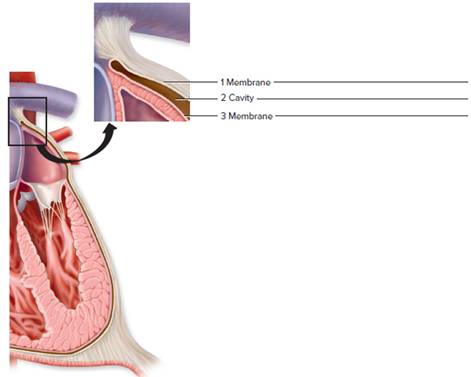
Laboratory Manual for Human Anatomy & Physiology Main Version
4th Edition
ISBN: 9781260159110
Author: Terry Martin
Publisher: Mcgraw-hill Higher Education (us)
expand_more
expand_more
format_list_bulleted
Textbook Question
Chapter 2, Problem F2.11A
FIGURE 2.11 Label the specific serous membranes and cavities (1—3) of the heart.

Expert Solution & Answer
Want to see the full answer?
Check out a sample textbook solution
Students have asked these similar questions
NOTES
and the left side serving the systemic circuit. In Figure 16-15, complete
the schematic showing the blood flow to and from the heart (the starting
points are given to you). Use a blue pen or pencil to denote the direction of
deoxygenated blood and a red pen or pencil for oxygenated blood flow.
Include the names of the major vessels, chambers, and valves involved,
based on the following list:
lung capillary beds
body capillary beds
right ventricle
left ventricle
bicuspid valve
superior vena cava
tricuspid valve
inferior vena cava
pulmonary semilunar valve
pulmonary trunk
aortic semilunar valve
R. and L. pulmonary arteries
R. and L. pulmonary veins
aorta
Pulmonary Circulation
Systemic Circulation
Right atrium
Left atrium
URA--YCK
HAT
Lungs
Body
Figure 16-15. Schematic of circulation
The heart is lateral to the lungs. True or false
Could you draw a picture of the flow of blood through the heart.
And label at least 10 chambers,vessels, or structures.
Could you also in the drawing include colors indicate which chambers or vessels are carrying oxygenated (red) blood or deoxygenated blood (blue)
Chapter 2 Solutions
Laboratory Manual for Human Anatomy & Physiology Main Version
Ch. 2 - The basis for communication in anatomy and...Ch. 2 - Which of the following is not a body cavity?...Ch. 2 - The pericardium is associated with the lung....Ch. 2 - The ____________ plane divides the body into left...Ch. 2 - The abdominopelvic cavity can be subdivided into...Ch. 2 - The larynx is part of the __________ system....Ch. 2 - The epigastric region is a portion of the _______...Ch. 2 - In the posterior view, the cubital region is...Ch. 2 - The brachial surface region pertains to the wrist....Ch. 2 - A frontal plane divides the body into anterior and...
Ch. 2 - Match the body cavities in column A with the...Ch. 2 - FIGURE 2.10 Label body cavities 1-5. Add a...Ch. 2 - FIGURE 2.11 Label the specific serous membranes...Ch. 2 - the organ systems in column A with the principal...Ch. 2 - Indicate whether each of the following sentences...Ch. 2 - Indicate whether each of the following sentences...Ch. 2 - Indicate whether each of the following sentences...Ch. 2 - Indicate whether each of the following sentences...Ch. 2 - Indicate whether each of the following sentences...Ch. 2 - Indicate whether each of the following sentences...Ch. 2 - Indicate whether each of the following sentences...Ch. 2 - Indicate whether each of the following sentences...Ch. 2 - Indicate whether each of the following sentences...Ch. 2 - Indicate whether each of the following sentences...Ch. 2 - Indicate whether each of the following sentences...Ch. 2 - Indicate whether each of the following sentences...Ch. 2 - FIGURE 2.12 Label the planes of the sectioned...Ch. 2 - Figure 2.13 Label the indicated body surface...Ch. 2 - Examine the letters A, B, and C indicated on...
Knowledge Booster
Learn more about
Need a deep-dive on the concept behind this application? Look no further. Learn more about this topic, biology and related others by exploring similar questions and additional content below.Similar questions
- trace a drop of blood from the left ventricle of the heart to the wrist of the right hand and back to the heart(name each vessel) then trace the drop of blood to the dorsum of the right foot and back to the right side of the heart.arrow_forwardOn a diagram of a frontally sectioned heart, indicate the location of the cardiac skeleton.arrow_forwardIf a drop of blood were going from the inferior vena cava to the heart, trace the path of that drop of blood from the vessel (IVC) through the four chambers of the heart, four valves of the heart and the lungs, in the correct sequence, ending with the drop of blood going into the aorta.arrow_forward
- The four-chambered heart is a single organ but is sometimes described as a “double pump” because it functions more like two pumps than one. Explain why this is so, including the names of the heart structures involved. please helparrow_forwardLabel the structures to the letter A- ____________ sac B- ___________ vena cava C- ___________ trunk D- ___________ arteries E- ___________ veins F- ___________ arch= G- thoracic ________ H- abdominal _______ I- J-arrow_forwardfill in the blanks Blood that has circulated to the heart muscle itself also returns to the right atrium. Once blood leaves the cells of the myocardium, it flows into a system of cardiac veins, eventually flowing into the great cardiac vein, and then the coronary sinus. On this anterior view of the heart, locate the great cardiac vein and the coronary sinus (shown through to the back). Slide 14: Identify the two large veins that merge and flow into the superior vena cava: A._________________________________ and B._________________________________. (Note that unlike the arterial system, there are two veins, a right and a left, with this name.) Locate either the right or left brachiocephalic vein. Each is formed by the union of two slightly smaller veins. An C.___________________________ vein draining the head and a D.______________________ vein bringing blood back from the arm. Locate an additional vein draining blood from the head that flows into the subclavian vein, the…arrow_forward
- Put the structures involved in blood flow through the heart in order, as blood flows from the body back to the heart, and then from the heart to the body. Question 5 options: right A-V valve pulmonary trunk mitral valve pulmonary veinsarrow_forwardThe diagrams show structures that comprise the external and internal regions of the heart. Label the components A to Larrow_forwardConsider the circulation of blood through the heart. Put the structures in the order that blood flows through them, starting with the superior and inferior venae cavae|(#1) and ending with the ascending aorta (#14).arrow_forward
- Structure of the Heart Use this table as a checklist for your study of the heart. Do not forget to fill in the function column. Structure Right atrium Computer Simulation Function(s) Sheep Human Left atrium Right ventricle ロ Left ventricle Interventricular sulcus Anterior interventricular artery ロ Great cardiac vein Small cardiac vein Right coronary artery Circumflex artery Left coronary artery Aorta Pulmonary artery Superior vena cava Inferior vena cava Interventricular septum Myocardium ロ Epicardium Parietal pericardium Pericardial space Fibrous pericardium ロ Mitral valve Tricuspid valve Chordae tendineae Papillary muscle ロ Aortic semilunar valve Pulmonary semilunar valve Copyright 2003 by Mosby, Inc. All rights reserved. 323arrow_forwardS2 heart sounds (“dub”) represent the closing of thearrow_forward____ blood pressure is blood pressure during heart dilationarrow_forward
arrow_back_ios
SEE MORE QUESTIONS
arrow_forward_ios
Recommended textbooks for you
 Human Physiology: From Cells to Systems (MindTap ...BiologyISBN:9781285866932Author:Lauralee SherwoodPublisher:Cengage Learning
Human Physiology: From Cells to Systems (MindTap ...BiologyISBN:9781285866932Author:Lauralee SherwoodPublisher:Cengage Learning Biology 2eBiologyISBN:9781947172517Author:Matthew Douglas, Jung Choi, Mary Ann ClarkPublisher:OpenStax
Biology 2eBiologyISBN:9781947172517Author:Matthew Douglas, Jung Choi, Mary Ann ClarkPublisher:OpenStax

Human Physiology: From Cells to Systems (MindTap ...
Biology
ISBN:9781285866932
Author:Lauralee Sherwood
Publisher:Cengage Learning

Biology 2e
Biology
ISBN:9781947172517
Author:Matthew Douglas, Jung Choi, Mary Ann Clark
Publisher:OpenStax

Respiratory System; Author: Amoeba Sisters;https://www.youtube.com/watch?v=v_j-LD2YEqg;License: Standard youtube license